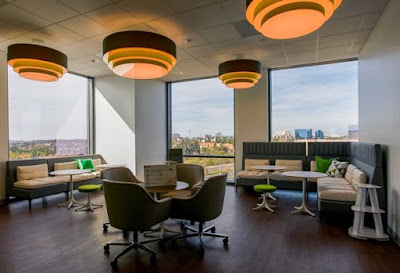FURNISHING COLLABORATIVE SPACE TO ENHANCE THE WORK ENVIRONMENT
Source:
Patricia Kirk, Bisnow June 8, 2017
Furnishing a flexible office space to create a
collaborative environment can be a daunting experience, regardless of how
long the space will be occupied.
Furnishing a flexible
office space to create a collaborative environment can be a daunting
experience, regardless of how long the space will be occupied.
Interior design and office furnishing pros Gensler’s Director of Workplace, Maria Martinico, ICE founder/CEO DeLinda Forsythe, CORT Business Development Executive Barbara Cavanaugh and Illumina’s Jenny Durbin shared their insight to furnishing an open, collaborative office space and the special requirements of that type of environment. Durbin, manager of Global Facilities Planning and Workplace Innovation at Illumina, said furniture is key to the design of any space, so it is important to bring in the furniture provider early, preferably along with the architect during the schematic design phase.
This could involve a furniture designer/dealer like ICE or leasing firm like CORT, depending on whether the user is a startup in growth mode or an established office user. Durbin suggested developing relationships with both types of furniture providers, because even established companies lease furniture for temporary spaces while renovations or new buildings are under construction. “What office users today really want is a ‘resimercial’ environment — a mixture of traditional and casual,” Cavanaugh said. “They want to feel like they’re working at home, but be able to collaborate with others." This includes the ability to work outdoors, Martinico said.
Interior design and office furnishing pros Gensler’s Director of Workplace, Maria Martinico, ICE founder/CEO DeLinda Forsythe, CORT Business Development Executive Barbara Cavanaugh and Illumina’s Jenny Durbin shared their insight to furnishing an open, collaborative office space and the special requirements of that type of environment. Durbin, manager of Global Facilities Planning and Workplace Innovation at Illumina, said furniture is key to the design of any space, so it is important to bring in the furniture provider early, preferably along with the architect during the schematic design phase.
This could involve a furniture designer/dealer like ICE or leasing firm like CORT, depending on whether the user is a startup in growth mode or an established office user. Durbin suggested developing relationships with both types of furniture providers, because even established companies lease furniture for temporary spaces while renovations or new buildings are under construction. “What office users today really want is a ‘resimercial’ environment — a mixture of traditional and casual,” Cavanaugh said. “They want to feel like they’re working at home, but be able to collaborate with others." This includes the ability to work outdoors, Martinico said.
Today’s workforce wants to
use laptops or tablets anywhere. Companies are building WiFi-enabled spaces
that blend formal with casual to create comfortable settings for meeting or
working in outdoor café-like settings, outdoor patios or terraces with soft
seating and tables. Forsythe, whose company not only sells office furniture but
also designs and locally fabricates it, said electrical and data ports are now
being built into outdoor furniture. Durbin said the pursuit of a homey
environment at work is changing Illumina's culture. Illumina is focused on
transforming the workplace and implementing programs and amenities to attract
top talent. Some of these workplace enhancements include more choice and sustainable
food options, child care, enhanced digital collaboration tools
(videoconferencing, 100% WiFi-enabled spaces), quiet library-style spaces, work
cafés, and sports and special-interest groups that encourage mindfulness and
work-life balance. Illumina also is considering opportunities for serving
beer/wine after hours to coincide with happy hour.
Cavanaugh said residential
furniture is soft and injects comfortable elements of home into the office and
softens sound. It is important to understand who will occupy the space and what
their activities will be. An effective furniture consultant will interview the
end users and create a space plan that addresses those needs, she said.
Forsythe said she uses “live edge” wood and other natural elements when
designing “resimercial” furniture to bring nature into the office space. The
use of natural materials provides a more welcoming environment that will
attract and retain talent, she said.
DISCLAIMER: This blog/article
has been curated from an alternate source and is designed for informational
purposes to highlight the commercial real estate market. It solely represents
the opinion of the specific blogger/author and does not necessarily represent
the opinion of Pacific Coast Commercial.
All content provided
on this blog is for informational purposes only. The owner of this blog makes
no representations as to the accuracy or completeness of any information on this
site or found by following any link on this site. The owner of will not be liable for any
errors or omissions in this information nor for the availability of this
information. The owner will not be liable for any losses, injuries, or damages
from the display or use of this information.
Keywords: San Diego Commercial Real
Estate For Sale, Commercial Property In San Diego, Commercial Real Estate In
San Diego, San Diego Investment Real Estate, Commercial Property Management In
San Diego, San Diego Commercial Property Management, Commercial Property
Management San Diego, Managed Commercial Property San Diego, C





Comments
Post a Comment